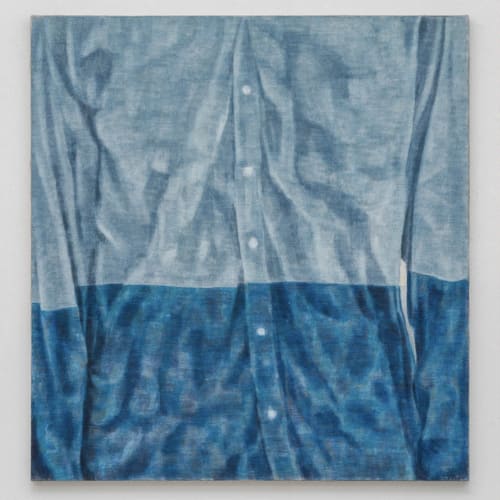In a solo exhibition currently at Tina Kim Gallery, fifteen paintings by Kang Seok Ho often zoom in to a detail of a person’s clothing, excluding the face and instead single-mindedly focusing on the formal details of pattern, color, and fabric texture. Rendered with a layered technique of tapping the paint onto the surface to produce roughly hewn, almost scabrous surfaces, these works lovingly transform creases in clothing into topographic landscapes, as in Untitled (undated): “I always compare the wrinkles in clothes to the ridges of mountains,” the artist said in a 2012 interview. He draws other comparisons: a buttock to a rock (as in Untitled [2002]), or a long, vertical painting of a woman’s slightly raised thigh under a skirt, and its attendant hilliness, as a valley in Untitled (2004).
This body of work, begun in Germany around 1999 and continued up to his death at the age of fifty in 2021, employs Kang’s signature use of photographs as source images. The accompanying materials in the exhibition showcase illuminating bits from the artist’s process, revealing how he tightly cropped photographs with masking tape, almost as if to bandage it, before enlarging the cropped image on a canvas. Kang’s method places him in the lineage of the Photorealists of the 1960s and 1970s, but unlike the historical Photorealists who sought to eliminate as many personal, conscious decisions as possible in the process of painting from photographs in pursuit of an extreme impersonality, Kang lets his hand show both in his rugged brushstrokes and painstaking cropping of images. The historical Photorealists, with a couple of exceptions like Robert Bechtle, mostly avoided painting figures in their works, out of a belief that figures tend to monopolize the psychological space of the canvas; Ralph Goings remarked in 1988 that, “the human form is such a hot image that attention tends to be drawn there to the sacrifice of everything else.” Interestingly, Kang resolves this problem by indeed incorporating figures, but leaving out their faces and depicting figures only by way of their zoomed-in clothing, thereby bypassing the potential compositional hijacking of the work by the figures.
Kang is careful, in his words, not to “reveal the subject too much.” He developed an unusual mode of portraiture through these works: portraiture devoid of faces or any other strong identifying markers. Without faces, these portraits deny us any real shortcut to meaning. It’s also equally difficult to ascertain the identity of a person from the body depicted in these paintings, as the compositions are so cropped as to obviate any bodily signifiers such as proportions, volume, or shape of limbs that would allow identification. His paintings quietly refuse us, instead making their depiction of clothing work overtime as both landscape and portraiture. In her book The Open Studio, literary scholar Susan Stewart notes, “From the presentation of the newborn as headfirst to the fixing of the death mask at the entrance to the house, the acknowledgement of the face is inseparable from the claim to personhood.” When we look at another’s face, she argues, we perceive nothing less than what is alive about this person. Drawing from the films of Michelangelo Antonioni that famously feature actors sitting with their backs to the camera, Kang’s paintings offer up another way of encountering the Other, a mode that is untethered from our usual cephalic way of encounter.
If what George Steiner wrote in Real Presences is true, that “there is language, there is art, because there is ‘the Other,’” then what are the stakes of picturing the Other through strictly the wrinkles and creases of their clothing that only obliquely hint at a real flesh and blood body underneath? Perhaps, these paintings suggest, it’s not necessary after all to always see in whole, an object or a person. When one tries to perceive all sides of an object (or in this case, person) simultaneously, the object ultimately becomes non-perspectival. That is to say, some perspectives are necessarily precluded from our view––think of a cup in front of you, with its far side blocked from view—precisely so that the object can be preserved and perceived as a three-dimensional object. Kang’s sartorial portraits-cum-landscapes suggest as much. Maybe even conventional facial portraits don’t reveal much more than Kang’s.


